Self-esteem is one of those topics that gets mentioned a lot. Everyone who uses the term has some idea of what it means. However, if you ask them to elaborate on it, they flail and hesitate, giving you the “it-is-what-it-is” look.
Truth is, there are some misconceptions about self-esteem out there. Low self-esteem, in particular, is poorly understood.

In this article, we’ll explore the concept of self-esteem in-depth, with an emphasis on low self-esteem. We’ll dig deep into why low self-esteem people behave the way they do and how they differ from those with high self-esteem.
After that, we’ll look at what’s behind the concept of self-esteem in humans- where it really comes from. Lastly, I’ll talk about what raises low self-esteem vs the generic advice people are given to raise their self-esteem.
Low self-esteem meaning
As you already know, people can either have low or high self-esteem. Self-esteem is simply one’s opinion of oneself. It’s how a person regards themselves. It’s a measure of our self-worth. Self-esteem is how valuable we deem ourselves to be. Self-esteem is self-evaluation.
People with a high level of self-esteem have a high opinion of themselves. They perceive themselves to be valuable and worthy human beings. In contrast, people with low self-esteem have a low opinion of themselves. They don’t believe they’re worthy individuals.
Herein lies the common misconception- low self-esteem doesn’t necessarily mean negative self-esteem. Low self-esteem people don’t necessarily hate themselves.
In fact, most of them neither love nor hate themselves. They’re neutral about themselves. They suffer more from a lack of positive self-beliefs than the presence of negative self-beliefs.
What causes low self-esteem?
Self-esteem is simply a set of beliefs we have about ourselves. High self-esteem people have many positive beliefs about themselves. Low self-esteem people have very few positive beliefs about themselves.
Where do these beliefs come from?
Mostly, they come from past experiences. A child who is loved and cherished is likely to develop positive self-beliefs that tip over into adulthood. People who achieve tremendous success in life also develop positive self-beliefs and thus tend to be high on self-esteem.
In contrast, factors like a bad childhood and no record of past successes are likely to contribute to low self-esteem. Experiencing enormous failures and being unable to reach one’s important goals lead to low self-esteem.
Now the thing with beliefs is that once in place, they tend to reinforce themselves. Hence, people behave in ways that are consistent with their levels of self-esteem.
High self-esteem people seek growth and opportunities to boost their self-esteem. They believe they deserve success. Low self-esteem people tend to forego such opportunities. They don’t believe they’re worthy of success.
Researchers have called these self-enhancing and self-protecting motivations.1
High self-esteem people seek to enhance themselves and low self-esteem people seek to protect themselves.
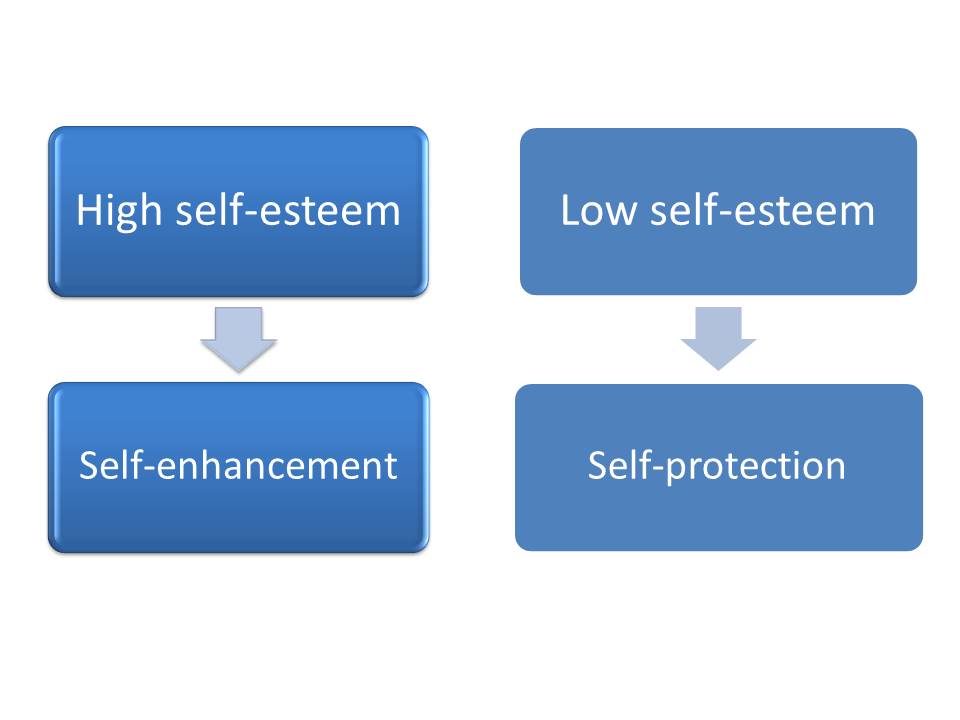
Identity and self-esteem
Our identity is the sum total of the beliefs we have about ourselves. The stronger our self-concept or identity, the stronger is our sense of self.
Low self-esteem people essentially lack a strong self-concept. They have self-concept confusion whereas people with high self-esteem have a strong sense of self. They have self-concept clarity.2
This again shows how low self-esteem is more about not knowing who you are than hating who you are. When you have negative self-esteem, i.e. you hate who you are, at least you know who you are. Low self-esteem people rarely have this problem. Their main problem is a weak sense of self.
How we see ourselves affects how we present ourselves to the world. If you’re unsure who you are, you won’t be confident in presenting yourself to others. To confidently interact with the world, we need a strong sense of who we are.
This is why people with low self-esteem tend to be shy and aloof. They don’t have a well-developed self with which to confidently interact with the world. They don’t stand up for their rights, needs, and wants.
When high self-esteem people enhance themselves, they behave in ways consistent with their self-identity.
When low self-esteem people protect themselves, they behave in ways consistent with their self-identity as well. They forego opportunities for growth and success because that’d make them more than what they really are.
Emotional effects of low self-esteem
Low self-esteem people are prone to feeling negative emotions such as anxiety, anger, and depression. Since they don’t have a firm basis for feeling good about themselves, their emotions are more at the mercy of the vicissitudes of life.
Since they don’t know who they are, they let others define them. This makes them more dependent on the opinion of others. They’re more vigilant and sensitive to the opinion of others.3
One moment they’re criticized, and they feel threatened. The next moment they’re praised and they feel good.
In contrast, high self-esteem people easily dismiss criticism or negative feedback that isn’t in alignment with their self-perceptions. As a result, their moods fluctuate little as a function of others’ opinions.
If they experience a serious setback, they can always point their attention to their alternate sources of self-worth. It’s this self-worth diversification that is the foundation of high self-esteem.
Self-esteem as a resource
To understand the self-enhancement and self-protection motives of high and low self-esteem people respectively, you need to view self-esteem as a resource.
Self-esteem largely remains stable throughout our adult life. When we’re young, we don’t have a good enough record of past successes. So our self-esteem is generally low. As we grow older and accumulate achievements, our self-esteem rises.4
Self-esteem can be both stable and fluctuating. A high level of stable self-esteem results from accumulated, net positive past successes. A low level of stable self-esteem results from a consistent lack of past successes.
New experiences can fluctuate the levels of self-esteem. If you experience a big failure, your self-esteem might take a hit. Whereas if you experience a big success, your self-esteem gets a boost.
Based on their past experiences, people can either have a low or high baseline level of self-esteem. There are different ways everyday self-esteem fluctuations affect people of low and high baseline levels of self-esteem.
Specifically, there are four possibilities:
1. High and stable
These are people who have a high general level of self-esteem, thanks to their many positive self-beliefs. They are less affected by self-esteem fluctuations of daily events. This can be graphically shown as under:
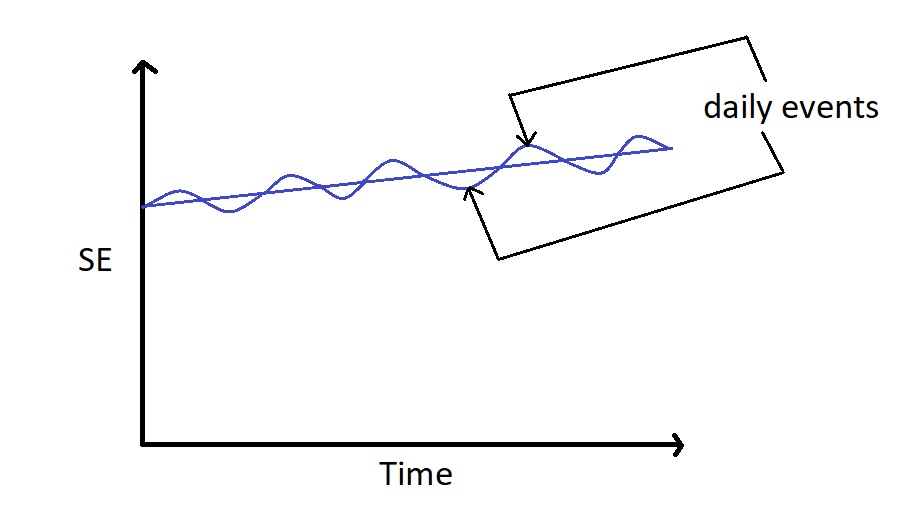
These people excel in several domains. Usually, they’ve achieved a high level of professional and social success.
The best way to think about self-esteem as a resource is to think of it as money deposited in a bank. People with a stable, high level of self-esteem have large sums of money deposited in several banks.
Let’s say they have $100,000 deposited in the professional success bank and another $100,000 in the social success bank. In other words, they’re at the top of their game professionally and have the best relationships.
These people are likely to engage in self-enhancing behaviours. Since they have more, they can invest more and make more. Companies offer them job opportunities and people invite them to parties all the time.
They maintain a general level of happiness, and fluctuations of daily events will not strike a big blow to their self-esteem.
If they get rejected at one job interview, they have dozens lined up and if their relationship with one friend is spoiled, hardly anything changes.
If you subtract $10 from both the $100,000 deposits, they still have $180,000. It’s like taking a drop out of an ocean.
If someone with a stable, high self-esteem experiences a big failure, they’ll take drastic measures to bounce back. They don’t expect to fail, but when failure happens, they do what they can to restore their previous, high level of self-esteem.
2. High and unstable
Say a person has high self-esteem in only one domain, i.e. they have $100,000 in one bank. Of course, this is risky. If an event strikes a major blow to their self-esteem, they’ll lose a lot.
Suppose this person is very successful professionally but has virtually non-existent social relationships. They derive all their self-esteem and self-worth from one source. If something were to happen to this source, they’ll lose a major chunk of their self-esteem.
Their self-esteem lacks diversification, which makes it unstable. If their sole source of esteem is threatened in a big way, they can’t turn to anything else.
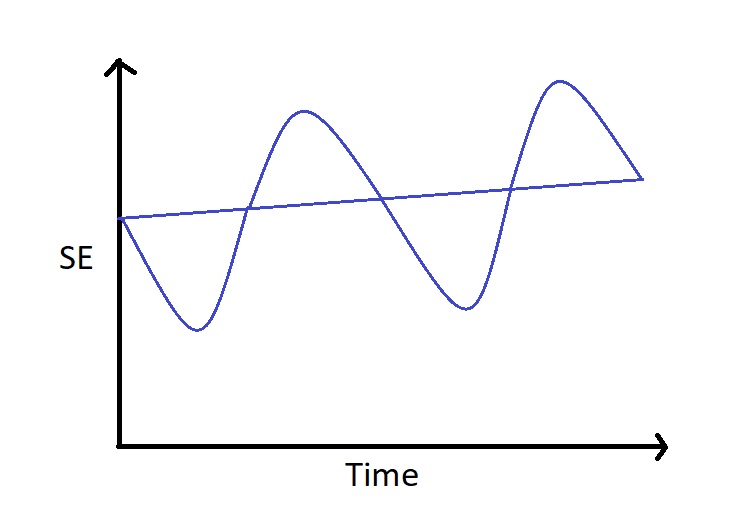
I’m sure you’ve come across people who’re very successful but still seem insecure. It’s because their self-esteem is entirely based on the success they’ve achieved in a single or a few domains. They lack self-esteem in other domains.
Of course, the domain in which they have succeeded is important to them, but there’s a constant threat in their mind that they might lose this success.
It may be they got to where they are in life via unfair means or nepotism. They probably lack the skills to maintain their success. If they were indeed skilled, the fear of losing their current success or esteem wouldn’t bother them as much.
People with unstable, high self-esteem are worried they might lose their self-esteem because it’s not based on firm foundations. The fear of losing their image or standing in society is high among them and they might go to any extent to defend it.
In contrast, those who derive their self-esteem from their skills enjoy high, non-fluctuating self-esteem because they know they can be successful in any domain. If they fail, they can re-build themselves.
Unstable high self-esteem is linked to high levels of aggression.5
A bully, for example, has an inflated but insecure sense of self. When a bully bullies others, he or she feels good, but when someone bullies them, their self-esteem crashes and they react aggressively.
3. Low and unstable
Now, let’s turn our attention to those with low but unstable levels of self-esteem. These are people whose general level of self-esteem is low. But they do experience times when their self-esteem gets occasional boosts.
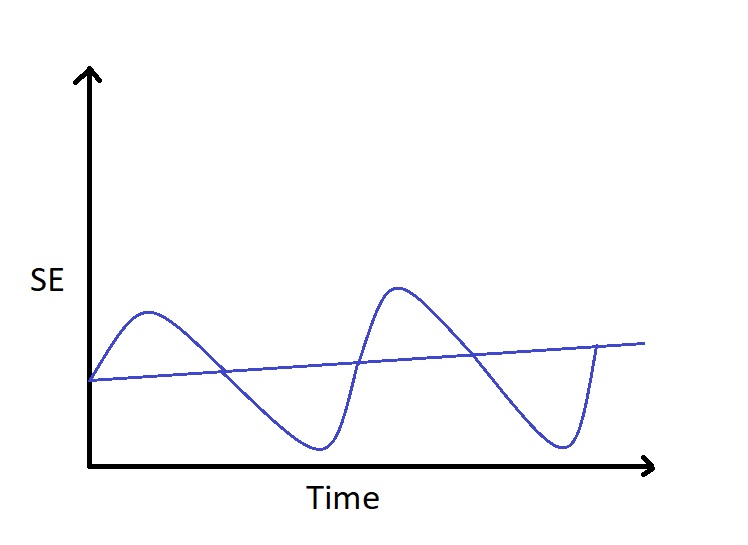
These people have a small record of past successes in all domains. Their low self-esteem makes them sensitive to external cues. When they’re praised, they’re elated. When they’re criticized, they’re dejected.
Since they have little success to bank on, they might compensate for that by exaggerating the success of daily events. But the failure of daily events hits them particularly hard.
4. Low and stable
These people have a stable, low general level of self-esteem. Even if something positive happens to them, they might discount it because it’s inconsistent with how they view themselves. Ever heard of fear of success?
They engage in self-protecting behaviours to the extreme. Their sense of self is super-weak. They don’t expect success and they prepare for failure. Failure is more familiar to them than success, so they prepare for it beforehand.
Interestingly, only low, stable self-esteem has been linked to depression. This is in line with the fact that depression isn’t about fluctuating moods. It’s more about the chronic, hard-to-overcome lowering of self-esteem.
People with a stable, low self-esteem only have, say, $100 in their self-esteem bank. If something bad happens and they lose $10, that’s a significant loss. That’s why they’re protective of whatever little they have. They tend to be risk averse.
If they take a risk, and failure happens, the loss will be too much to bear. Ironically, the only way for them to increase their baseline level of self-esteem is to aim for more. If they succeed, they can then try for more and set forth on an upward spiral of self-esteem.
Make no mistake- people with low self-esteem do desire self-enhancement. Every human being does. But they avoid pursuing success directly because of the risks involved. So they seek indirect methods of self-enhancement.
For instance, they may identify with their social group- their race, country, etc. That’s a nice little source of self-worth you don’t need to risk anything for. Or they may seek the company of those who’re doing worse than them. As they say, misery loves company.
Putting others down is another common method. Also, low self-esteem people will often point out the negative traits of high self-esteem people to feel better in comparison.
Depressed people with low self-esteem do have positive self-views in a few domains. As expected, they’re protective of these domains and feel very good by derogating others along these domains.
Digging deeper into self-esteem
Okay, we now have a clear idea about how low self-esteem people differ from high self-esteem people in how they think, feel, and behave. All this begs the question: What’s the basis of self-esteem itself?
Why is it that achieving certain things raises our self-esteem?
If I have low self-esteem, why can’t I one day just decide that I’m not a low self-esteem person and act like a high self-esteem person? Affirmations?
The reality of self-esteem is that it’s a bit of a misnomer. Self-esteem, at its core, is other-esteem because it’s derived from others.
Earlier, we defined self-esteem as how we value ourselves. How we value ourselves ultimately depends on how others value us. Don’t forget that we’re social species and we can’t really have self-esteem without other-esteem.
High self-esteem results from achieving things or having the qualities that others deem valuable. There are certain things that society deems valuable, and there’s nothing anyone can do about that. More on that later.
So the foundation of self-esteem is social acceptance.
According to the sociometer model of self-esteem, people with low self-esteem don’t feel bad because of low self-esteem per se. Rather, it’s the perceived or real social rejection that makes them feel bad.6
A low self-esteem person feels anxious in a social situation because they either feel rejected by the social group or worry they might be rejected. To avoid threatening their social acceptance, they avoid any behavior that might be unacceptable to others.
This overlaps nicely with the self-protection motivation we discussed earlier. Negative emotions such as anxiety and depression are thus signals that warn a person that they’ve just endangered their social acceptance.
Social acceptance and competence are the pillars of self-esteem. And you can’t just develop competence in any area and make claims to high self-esteem. You have to develop competence in an area that others value and accept.
Therefore, competency also boils down to social acceptance.
Why do you think almost all the children dream of becoming top actors, singers, scientists, astronauts, sports stars, etc.?
Reaching the top in these professions has one thing in common- fame. Fame is just another word for widespread social acceptance. Children learn that these professions have a wide social appeal, and if they were to pursue any one of them and succeed, they’d be accepted and valued widely.
It’s social acceptance they’re really after, not professional success and competence per se that are mere vehicles to social acceptance. They want to be super successful so that they can lift themselves up in the eyes of others.
Hence, people are not born talented or gifted in a particular domain. They develop their talents in areas likely to bestow them fame.
Coming back to competency: Of course, you can develop competency in any skill you want. But if no one values that skill, developing such competency won’t boost your self-esteem.
It’s important to point out here that when I say raising self-esteem is all about lifting yourself in the eyes of others, I don’t necessarily mean in the eyes of all humanity. To boost your self-esteem, you only need to gain the acceptance of the people you consider your own, i.e. your in-group.
People skilled in abstract art, for instance, may have difficulty finding others who value their art. As long as they find a group of people- no matter how small- that values abstract art, their self-esteem will thank them.
This extends to any skill or competency. To achieve success and boost your self-esteem, you have to find your tribe that values your competencies.
When people become successful, they’re tempted to share their success with their social group. It’s as if without doing that your success is sort of meaningless.
Recently, I was watching an interview of a bodybuilder who talked about how he felt humiliated in front of his family and friends when he lost his first competition.
He said that it motivated him to work hard. So he did and fought the competition again. He specifically mentioned that he wanted his family and friends to see him win. And they did.
The whole thing made me wonder how much of his victory was about winning the competition per se and how much was about re-gaining esteem in the eyes of his own people.
It all comes back to… reproductive success
Why gain the acceptance of your social group?
We’re a social species that, over evolutionary time, had a lot to gain from our social groups. When others in your group value you, you raise in rank in your social group. In primates, a rise in status correlates with increased access to resources and mating opportunities.
Having a trait like physical attractiveness automatically makes you valuable in the eyes of others. Physically attractive people generally enjoy higher levels of self-esteem.
If you’re physically attractive, you’re likely to find attractive mates to breed with, thereby increasing your reproductive success directly and that of your social group, indirectly.
Ever experienced that slight boost in self-esteem when you’re in the company of an attractive member of the opposite sex? And those looks that people give you? You temporarily raise yourself in their eyes because you must be valuable if you’re in the company of someone valuable.
Ancestral humans moved around in tribes that typically had a male patriarch who owned a territory (main resource). Because he owned territory and enjoyed access to females, he had high status.
Even today, people exhibit this territoriality.
Who are the people who enjoy high status? It’s invariably those who own the most- those who have the most resources (territory). No wonder it’s these very people who have the highest levels of self-esteem.
The inevitability of social comparison
A common advice many experts give to people with low self-esteem is:
“Stop comparing yourself to others.”
Here’s the thing- comparing ourselves to others has had a long evolutionary history.7
In other words, it’s impossible to stop comparing yourself to others. Social comparison plays a critical role in letting us know where we stand compared to others in our social group.
If we find we’re better than them, our self-esteem rises. If we find they’re better than us, our self-esteem drops.
The self-esteem drop motivates us to perform actions that will raise our self-esteem. Sure, finding out that others are better than you feels bad, but you have to remind yourself what these bad feelings are for.
The bad feelings associated with low self-esteem are there to motivate you to raise your rank in your social group. This is the only way to raise your self-esteem. Other common advice dished out is “silence your inner critic” and “practice self-compassion”.
Once you lift yourself in the eyes of others and gain self-esteem, your inner critic will shut up by itself and self-compassion will happen naturally. Your harsh inner critic is harsh when you’ve done little to gain self-esteem.
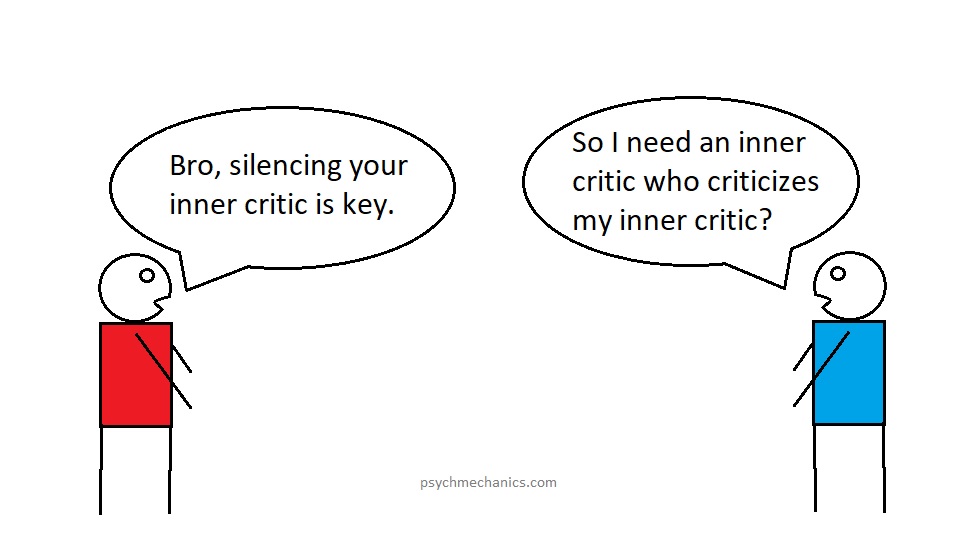
And how can you possibly practice self-compassion when you’re at the bottom in your social group? The mind is designed to lift you up in rankings, not make you “accept yourself” if what you are is unacceptable to others, and to you.
Being okay with not feeling self-compassion is the real self-compassion. Allowing yourself to feel the unpleasant emotions of having low self-esteem and working to build your self-esteem is what raises self-esteem.
“Compare yourself to yourself”, they add.
Our ancestors compared themselves to others. They were not in competition with themselves. Having this ability to compare their standing with others, they learned where they should focus their efforts to rise in rank and gain access to resources.
While it feels good to see how far we’ve come, if we want to go further, we have to compare ourselves to others who’ve gone further. There’s no version of us that has gone further.
References
- Tice, D. M. (1998). Social motivations of people with low self-esteem. U: RF Baumeister (ur.), Self-esteem. The puzzle of low self-regard (pp. 37-53).
- Campbell, J. D., & Lavallee, L. F. (1993). Who am I? The role of self-concept confusion in understanding the behavior of people with low self-esteem. In Self-esteem (pp. 3-20). Springer, Boston, MA.
- Rosenberg, M., & Owens, T. J. (2001). Low self-esteem people: A collective portrait.
- Orth, U., & Robins, R. W. (2014). The development of self-esteem. Current directions in psychological science, 23(5), 381-387.
- Baumeister, R. F. (1993). Understanding the inner nature of low self-esteem: Uncertain, fragile, protective, and conflicted. In Self-esteem (pp. 201-218). Springer, Boston, MA.
- Leary, M. R., Schreindorfer, L. S., & Haupt, A. L. (1995). The role of low self-esteem in emotional and behavioral problems: Why is low self-esteem dysfunctional?. Journal of Social and Clinical Psychology, 14(3), 297-314.
- Gilbert, P., Price, J., & Allan, S. (1995). Social comparison, social attractiveness and evolution: How might they be related?. New ideas in Psychology, 13(2), 149-165.
